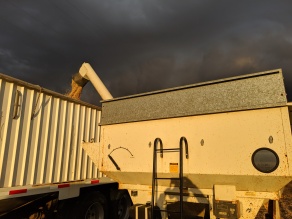Upcoming Events:
Nov. 4, 5, 13, 14: Know Your Numbers, Know Your Options, 1-4 p.m., WCREC, North Platte
Nov. 18: CSI for Youth: Soil sampling, 5 p.m., jrees2@unl.edu
Nov. 18: Ag Land Management Webinar, 6 p.m., Register: https://agecon.unl.edu/landmanagement
Nov. 20: Pheasants Forever Cover Crop Field Day, 9 a.m.-1 p.m., 4-H Building York, RSVP 402-362-5508
Nov. 22: NE Agribusiness Association Research Symposium, Holthus Convention Center, York
Nov. 26: York County Corn Grower Annual Meeting, Chances R, York
Dec. 12-13: Know Your Options, Know Your Numbers, 10 a.m.-4 p.m., Fairgrounds, Ord
Dec. 16: CSI for Youth: Soil sample results, 5 p.m., jrees2@unl.edu

Crop Update: So grateful for this past week’s weather in aiding harvest progress! Also grateful to all the growers who worked with me in on-farm research this year and for all the studies harvested this past week!
One of the more frequent questions/comments I’ve received the past few weeks is regarding yields. It sounds like irrigated yields for corn and even soybean are around 5-15% lower than what farmers hoped for in this part of the State. Most aren’t necessarily ‘bad’ yields, just not what was desired. Irrigated corn is mostly going 225-245 bu/ac with high-yielding genetics and everything else aligned correctly going 250-265 bu/ac. And, as more fields are harvested, there may be some better yields due to the long grain fill period. There’s irrigated fields of soybeans that did 50-60 bu/ac. What is positive is non-irrigated yields for both corn and soybeans with non-irrigated beans sometimes out-yielding the irrigated ones.
The impacts of the difficult cold, wet planting season could be seen season-long in fields

Plant to plant variability impacting kernels/ear.
with uneven plant emergence and eventually variable ear height and kernels/ear. That plant to plant variability can add up to yield impacts more than one realizes. There’s also field variability due to ponding/flooding in fields, hail/wind damage, and additional challenges during harvest with wind and moisture leading to lodging and/or ear loss and some soybean shatter.
The high humidity and leaf wetness along with cool, wet weather allowed for more disease in both corn and soybean. Perhaps one reason why non-irrigated corn and soybean are yielding well was due to reduced disease pressure from reduced plant population and increased air flow. I know of a handful of irrigated soybean fields in 2019 planted on seed corn acres where, to the line, the soybean on seed corn had more sudden death syndrome (SDS) pressure and less yield than the soybean on soybean corners of fields. I had never before seen this so striking.

Same soybean variety. Yellow area is soybean planted on seed corn residue under pivot with heavy SDS pressure. Green area to the line is soybean on soybean in pivot corners.
My hypotheses: 1-Test for soybean cyst nematode in the seed corn acres vs. corners. Anything that will move soil will move SCN, including equipment. 2-Fusarium virguliforme (pathogen that causes SDS), reproduces best on corn kernels followed by corn residue, followed by soybean seeds and residue. Even if the seed corn acres had a cover crop and were grazed, cattle don’t easily pick up loose kernels lost to the 2018 hail storm or harvest loss. 3-SCN in the field + great conditions for SDS in 2019 allowed for synergistic effect of more SDS and yield loss.
Cloudy weather also played a role in photosynthesis and ultimately yield. Dr. Roger Elmore and colleagues shared the following research on shading and yield impacts. “Many researchers have investigated the effects of lower solar radiation on corn using shade cloth of different densities. These can effectively block solar radiation by 10% to 90% or more (e.g., Schmidt and Colville 1967, and Reed et al. 1988). Invariably they found that shading the crop two to three weeks after silking (R1) reduced yields more than shading before R1. Most also find that hybrids differ in their responses to shading.” (This can help explain the tip back due to kernel abortion some of you asked me about after pollination). “Very few researchers used shade cloth during the grain-fill period, which would be similar to the reduced solar radiation period central Nebraska experienced the third week of August.
Early et al., 1967, shaded plants around the “reproductive phase” for 21 days as well as during the “vegetative stage” for 54 days and the “maturation phases” for 63 days. Shading during reproductive stages reduced plant yields the most, but 30% shading during the maturation stages ― what we consider the seed set and grain-fill periods (R2-R6) ― not only reduced yield per plant 25% to 30% but also reduced kernels per plant and the amount of protein per plant. Researchers in a new study shaded plants from silking to maturity (R1-R6) (Yang et al., 2019). Shading reduced yields more with higher plant populations than with lower populations.” (This may also help explain why non-irrigated fields with lower plant populations may have good yields in spite of cloudy conditions in 2019).


































